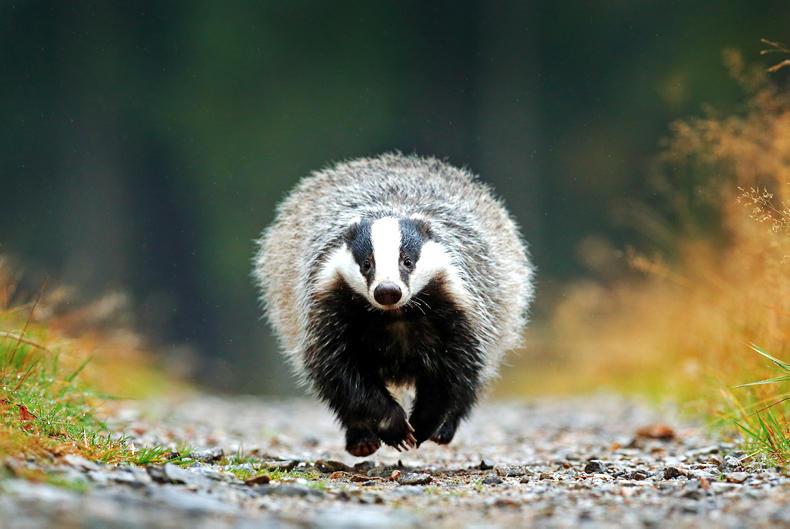Research focused on the movement patterns of badgers has recommended that the TB vaccination programme should focus on badger cubs.
The study, carried out by researchers in Trinity College Dublin, took place in Co Wicklow over a seven-year period and monitored the movement of badgers away from their native social groups.
Of the badgers tracked in the study, just 18% dispersed from their homes. Those badgers leaving their set present the greatest risk for the transmission of TB.
Lead author on the paper Aoibheann Gaughran said: “It’s fair to say most badgers don’t leave home – they remain living in the territory where they are born. However, some of those that did move away went on unexpectedly long and complex journeys.”
Movements
A single travelling badger can visit as many as 20 other groups, presenting a significant transmission risk. This transmission occurs mainly through respiratory transfer and bite wounds inflicted during fights.
Gaughran said: “Dispersal begins when badgers are aged one year or older, but by vaccinating them as cubs we can avoid the disease-spreading implications of this behaviour.”
Ideally, just those badgers dispersing would be vaccinated. However, no way was found to identify these individuals before they moved.
Autumn was identified as the best time to vaccinate cubs, as 71% of badgers dispersed in January and February.
Distance
Badgers that left their native set often settled down nearby. Researchers recorded an average dispersal distance of just 3.1km when measured in a straight line.
However, these badgers covered an average distance of 120km en route to finding a new social group.
Measuring in a straight line can severely underestimate how far the badgers travel, researchers said.
The highest recorded movement was for a female badger. This badger eventually settled 1.5km from her home set, but travelled 308km passing through 22 different territories on the way there.
Gender differences
Gaughren said: “By using GPS satellite trackers to take a uniquely personal look at the nightly comings and goings of 80 of these badgers in the wild, we discovered that some, particularly the females, could cover over 100km while wandering around large areas looking for their new home.
“Male badgers, on the other hand, liked to stay close to their mammy, and typically just moved next door.”
The research was published in the Ecology and Evolution journal and is available here.
Read more
Roadworks ‘unlikely’ to cause TB spread from badgers – study
€2.6m fines to focus attention on TB changes
Research focused on the movement patterns of badgers has recommended that the TB vaccination programme should focus on badger cubs.
The study, carried out by researchers in Trinity College Dublin, took place in Co Wicklow over a seven-year period and monitored the movement of badgers away from their native social groups.
Of the badgers tracked in the study, just 18% dispersed from their homes. Those badgers leaving their set present the greatest risk for the transmission of TB.
Lead author on the paper Aoibheann Gaughran said: “It’s fair to say most badgers don’t leave home – they remain living in the territory where they are born. However, some of those that did move away went on unexpectedly long and complex journeys.”
Movements
A single travelling badger can visit as many as 20 other groups, presenting a significant transmission risk. This transmission occurs mainly through respiratory transfer and bite wounds inflicted during fights.
Gaughran said: “Dispersal begins when badgers are aged one year or older, but by vaccinating them as cubs we can avoid the disease-spreading implications of this behaviour.”
Ideally, just those badgers dispersing would be vaccinated. However, no way was found to identify these individuals before they moved.
Autumn was identified as the best time to vaccinate cubs, as 71% of badgers dispersed in January and February.
Distance
Badgers that left their native set often settled down nearby. Researchers recorded an average dispersal distance of just 3.1km when measured in a straight line.
However, these badgers covered an average distance of 120km en route to finding a new social group.
Measuring in a straight line can severely underestimate how far the badgers travel, researchers said.
The highest recorded movement was for a female badger. This badger eventually settled 1.5km from her home set, but travelled 308km passing through 22 different territories on the way there.
Gender differences
Gaughren said: “By using GPS satellite trackers to take a uniquely personal look at the nightly comings and goings of 80 of these badgers in the wild, we discovered that some, particularly the females, could cover over 100km while wandering around large areas looking for their new home.
“Male badgers, on the other hand, liked to stay close to their mammy, and typically just moved next door.”
The research was published in the Ecology and Evolution journal and is available here.
Read more
Roadworks ‘unlikely’ to cause TB spread from badgers – study
€2.6m fines to focus attention on TB changes






 This is a subscriber-only article
This is a subscriber-only article










SHARING OPTIONS: